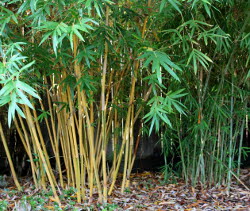Bamboo, used to be called the poor mans’ lumber, is considered today by many bamboo enthusiasts as the “green gold.” It serves as material for construction, handicraft and furniture making, fishpen and other agricultural and industrial uses.

The propagation and plantation establishment technology for many commercial species of bamboo is now available. These species, namely, kauyan tinik, kauyan killing, bayog and bolo can propagated by culm cuttings, which can be directly planted in a plantation site or raised in a nursery for mass propagation.
TECHNOLOGY AND PROCESS
Nursery Techniques
A. Selection and preparation of planting stock
– Select planting stocks from healthy bamboo clumps
– Select culms that are 1.5 t0 2 years as source of cuttings
– Extract the selected culm from the clump using sharp bolo or saw to avoid splitting
– Clean the selected culm by pruning the branches, leaving 1-2 internodes of the branch intact. Do not remove the buds.
– Cut the culms into 1 or 2 nodes cuttings. The 1 node cuttings produce more planting stocks. However a 2 node cutting is more advantageous when frequent watering is not possible.
B. Potting
– Use polyethylene bags as potting materials. The size of the bags may vary depending on the size of the cuttings.
– Use pulverized top soil with high organic matter a spotting media.
– Position the cutting vertically in the plastic bags with the first node embedded in the soil and the second node exposes.
– Compact the soil in the bag moderately
– Water the new potted cuttings. The upper internode should always be filled with water.
– Place the newly potted cuttings in a shaded areas for about 2-3 months.
– Water the new potted cuttings regularly to maintain adequate moisture.
– Plant propagules 5-6 months after potting.
Plantation Establishment
A. Site selection
Commercial bamboo species in the Philippines thrives in a wide range of site characteristics although it prefers well-drained sandy loam soil at low to medium altitudes. Bamboo also thrives in cogonal and marginal areas.
B. Site preparation
– Clear the area from weeds and unwanted vegetation
– Prepare the planting hole in advance. Each hole should be wide and deep enough to accommodate the potted propagules. The bigger the planting holes, the better for the growth of the propagules.
– Space the bamboo into 7×7 meters. For riverbank stabilization, 5×5 meters planted in quincunx method is recommended.
C. Planting
– Loosen the soil in previously prepared holes
– Cut and remove the plastic bags carefully without breaking the pottings and damaging the roots of the propagules.
– Put the propagules vertically into the planting holes with soil intact and cover them with well-pulverized soil.
– Gently compress the soil around the newly planted plants and mulch the plant
D. Plantation maintenance and protection
– Conduct regular ring weeding and strip brushing
– Apply fertilizer when necessary
– Construct firelines if needed
– Replace dead plants immediately
MARKETING CONSIDERATION
A Commercial bamboo species are readily marketable as construction material and as raw material for furniture and handicraft industries. “Bamboo yards can be found in the provinces as market outlet. Bamboo poles can also be bought from plantation sites.
FINANCIAL CONSIDERATION
The estimated cost of developing a bamboo plantation is P30 – 35,000 per hectare which includes nursery operation, plantation establishment, maintenance and protection. This amount may vary depending on site characteristics, quality and accessibility and the bamboo species to be planted.
ECOLOGICAL BENEFITS
A Bamboo can be used to rehabilitate the country’s large tracts of denuded land. Bamboo’s wide range of adaptability to adverse soil and climatic conditions make it an ideal crop reforesting barren and grassland areas of the country. A fast-growing plant with a massive root system, bamboo is effective in controlling soil erosion and stabilizing riverbanks.
SOCIOECONOMIC BENEFITS
Income can be derived after 5 to 7 years. On the 5th year, 5 poles can be harvested/clump. At 200 clump/ha, 1000 poles can be harvested in a one-hectare plantation. At an average price of P50/pole, the expected income is P50,000/ha. Pole production is expected to increase as the plantation matures.
SUPPORT SERVICES
Technical assistance on bamboo propagation and plantation development is available at ERDB and all DENR Regional Offices and Local Government Units. The DENR is also tapping technical and other forms of assistance from local and foreign donors.
RELEVANT LAWS AND REGULATIONS
DENR Administrative Order No. 31, dated June 24, 1991, includes bamboo as one of the reforestation species for contract reforestation.
PD 705 as amended, and EO No. 192 date June 10, 1987, DENR Administrative Order No. 59 series of 1993, govern the transport and shipment of timber and non-timber forest products including bamboo.
MANAGEMENT CONSIDERATION
Except for adverse climatic conditions such as prolonged drought and typhoons, there is no potential risk involved in bamboo plantation development. Bamboo’s wide range of site adaptability provides a high rate of success. Bamboo planting can be undertaken by individual farmers or communities.
Source: neda.gov.ph

Hello Mr. Danny Smit,
We have ten (10+) hectares for bamboo plantations.
In Bato, Camarines Sur, Island of Luzon, Philippines.
We are interested in your advice.
Thank You,
Hello,
We are interested to know bamboo farmers that produce bamboo for straws. We want to produce the straws here in the Philippines and export this to Europe.
Any advise or help will be highly appreciated. We can even look into setting up a bamboo farm long term.
Thank you
@ Danny Smit we also have 100 HECTARES ideal for your bamboo farm.